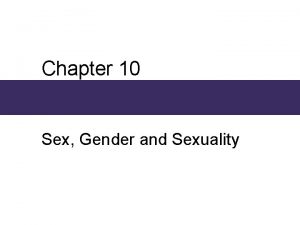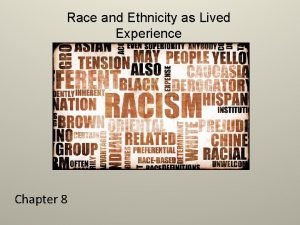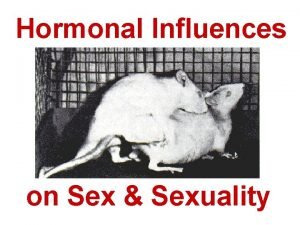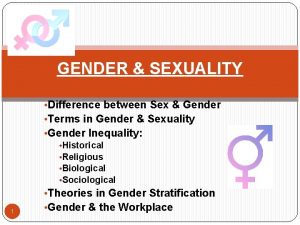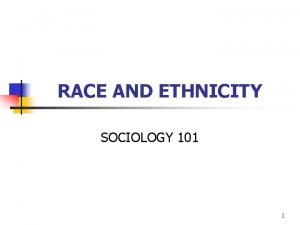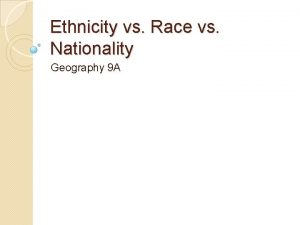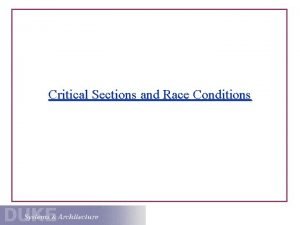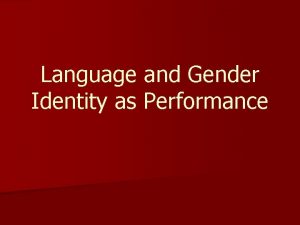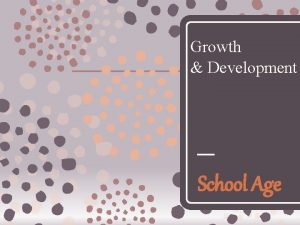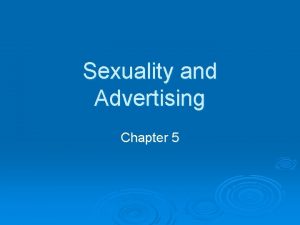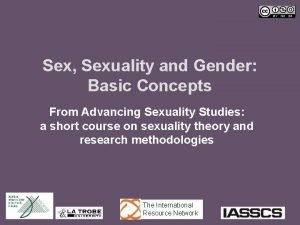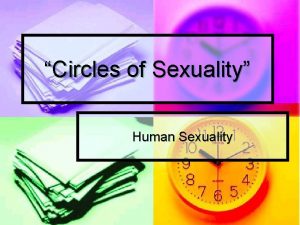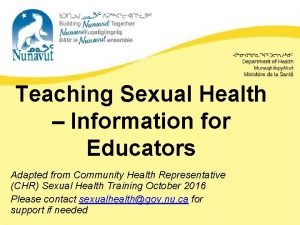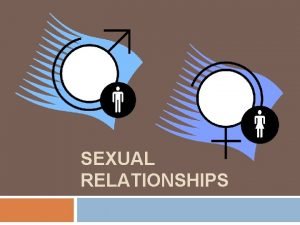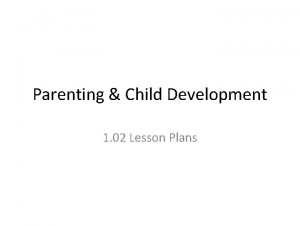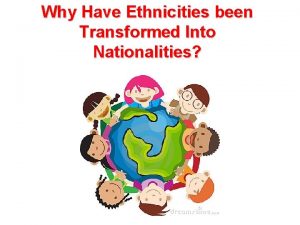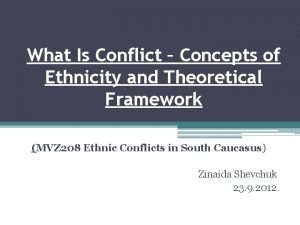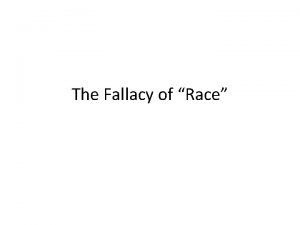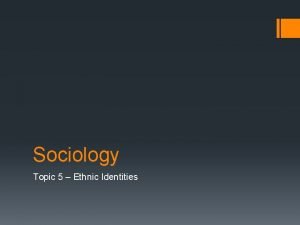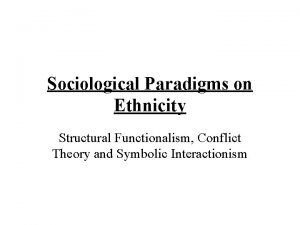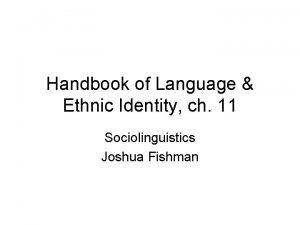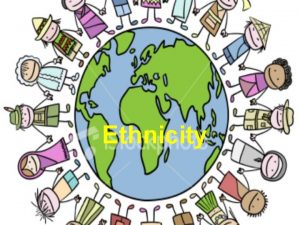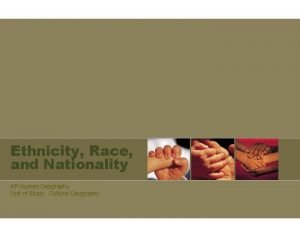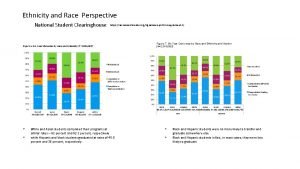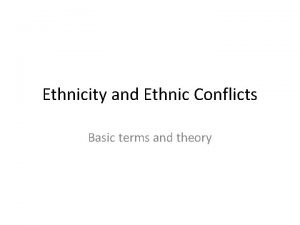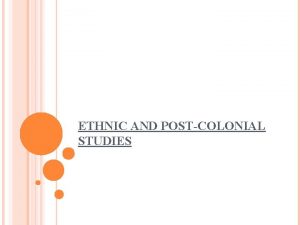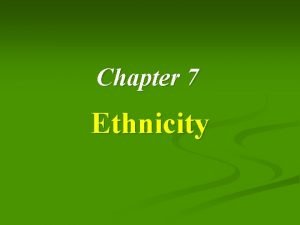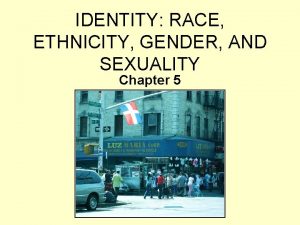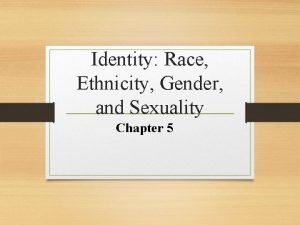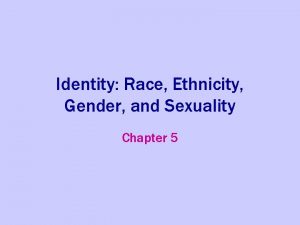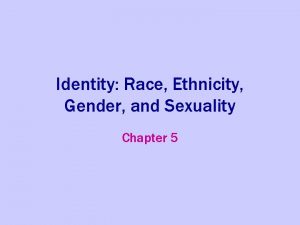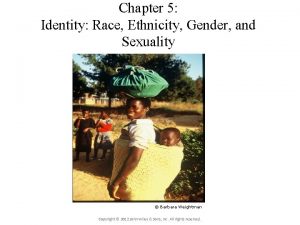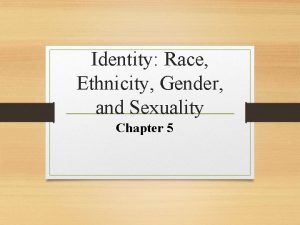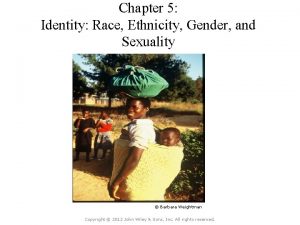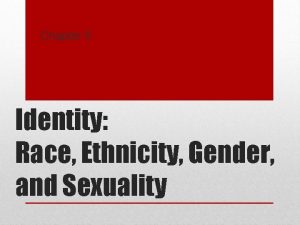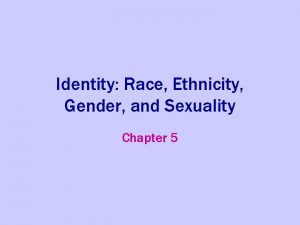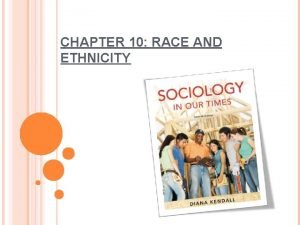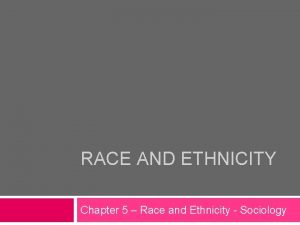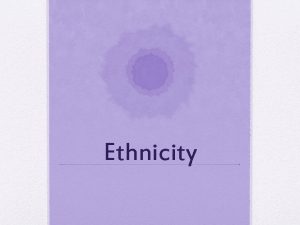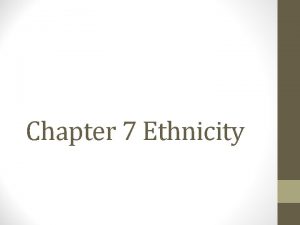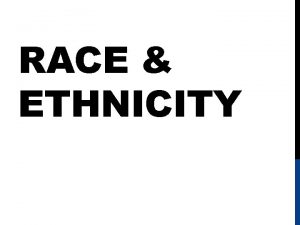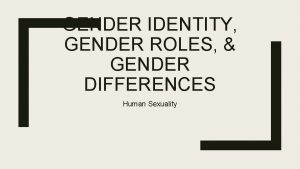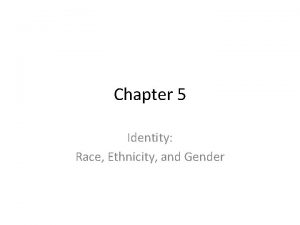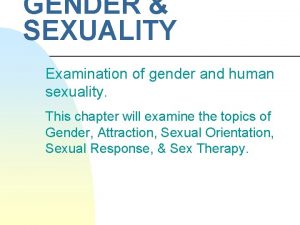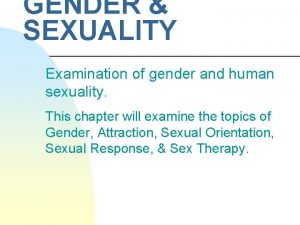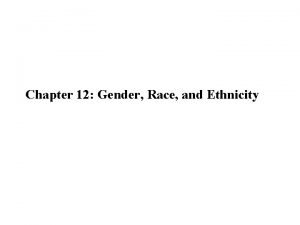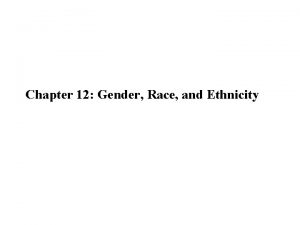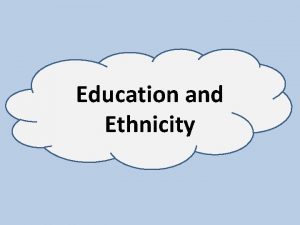Chapter 5 Identity Race Ethnicity Gender and Sexuality








































- Slides: 40

Chapter 5: Identity: Race, Ethnicity, Gender, and Sexuality Concept Caching: Woman Headload and Baby-Malawi © Barbara Weightman Copyright © 2012 John Wiley & Sons, Inc. All rights reserved.

Field Note: Building Walls “ “Traveling on the Indonesian island of Bali, I saw a brick-making facility and stopped to visit. Boys and women were building bricks by hand, in the hot sun. I watched young boys scoop wet mud from a quarry by a creek into their wheelbarrows. They poured the mud into wooden forms. Once the bricks began to dry and harden in the sun, someone had to turn the bricks repeatedly to prevent them from cracking. The woman in Figure 5. 1 worked ten hours a day, six days a week, turning, stacking, and re-stacking bricks to prevent them from cracking. For her work, she earned about 45 cents (U. S. ) per hour. ” © 2012 John Wiley & Sons, Inc. All rights reserved.

Key Question What is identity, and how are identities constructed? © 2012 John Wiley & Sons, Inc. All rights reserved.

What Is Identity, and How Are Identities Constructed? • Geographer Gillian Rose defines identity as “how we make sense of ourselves. ” • We construct our own identities through experiences, emotions, connections, and rejections • Identifying against other people: define the “Other, ” and then we define ourselves in opposing terms © 2012 John Wiley & Sons, Inc. All rights reserved.

Race • “Races” are the product of ways of viewing minor genetic differences that developed as modern humans spread around the world © 2012 John Wiley & Sons, Inc. All rights reserved.

What Is Identity, and How Are Identities Constructed? Race • Many of societies’ modern assumptions about race grew out of the period of European exploration and colonialism • Racism • What society typically calls a “race” is in fact a combination of physical attributes in a population • Skin color is not a reliable indicator of genetic closeness © 2012 John Wiley & Sons, Inc. All rights reserved.

Field Note Concept Caching: Fenway Park, Boston, MA “We were traveling in Darwin, Australia, in 1994 and decided to walk away from the modern downtown for a few hours. Darwin is a multicultural city in the midst of a region of Australia that is largely populated by Aboriginals. At the bus stops on the outskirts of the city, Aboriginals reached Darwin to work in the city or to obtain social services only offered in the city. With a language barrier between us, we used hand gestures to ask the man in the white shirt and his son if we could take their picture. Gesturing back to us, they agreed to the picture. Our continued attempts at sign language soon led to much laughter among the people waiting for the next bus. ” © 2012 John Wiley & Sons, Inc. All rights reserved.

What Is Identity, and How Are Identities Constructed? Race and Ethnicity in the United States • Unlike a local culture or ethnicity to which we may choose to belong, race is an identity that is more often assigned. • U. S. racial categories are reinforced through residential segregation, racialized divisions of labor, and categories of races recorded by the Census Bureau and other government and nongovernmental agencies. • Because of immigration and differences in fertility rates, the United States is increasingly “nonwhite. ” • How Americans define “race” is changing. © 2012 John Wiley & Sons, Inc. All rights reserved.

© 2012 John Wiley & Sons, Inc. All rights reserved.

What Is Identity, and How Are Identities Constructed? Residential Segregation • Geographers Douglas Massey and Nancy Denton: residential segregation is the “degree to which two or more groups live separately from one another, in different parts of the urban environment. ” • Five measures of segregation: evenness, exposure, concentrated, centralized, clustered. © 2012 John Wiley & Sons, Inc. All rights reserved.

INSERT FIGURE 5. 5 © 2012 John Wiley & Sons, Inc. All rights reserved.

What Is Identity, and How Are Identities Constructed? Identities across Scales • Different identities at different scales: • Individual: brother, sister, student • Local: residents of a neighborhood • Regional: Southerners • National: American • Global: Western, free • Appropriate identity is revealed at the appropriate scale. © 2012 John Wiley & Sons, Inc. All rights reserved.

What Is Identity, and How Are Identities Constructed? The Scale of New York • New York has a greater number and more diversity of immigrants than any other city in the United States. • Succession: New immigrants to a city often move to low-income areas being slowly abandoned by older immigrant groups. • Many new immigrants focus on the streetscapes, creating businesses to serve their community and reflect their culture. © 2012 John Wiley & Sons, Inc. All rights reserved.

Recall the last time you were asked to check a box for your race. Does that box factor into how you make sense of yourself individually, locally, regionally, nationally, and globally? What impact might it have on how other people view you? © 2012 John Wiley & Sons, Inc. All rights reserved.

Key Question How do places affect identity, and how can we see identities in places? © 2012 John Wiley & Sons, Inc. All rights reserved.

How Do Places Affect Identity, and How Can We See Identities in Places? Figure 5. 8 New Glarus, Wisconsin. The town of New Glarus was established by immigrants from Switzerland in 1845. The Swiss American town takes pride in its history and culture, as the flags at the New Glarus Hotel Restaurant demonstrate. © Don Smetzer/Alamy © 2012 John Wiley & Sons, Inc. All rights reserved.

How Do Places Affect Identity, and How Can We See Identities in Places? • Geographer Gillian Rose: “Developing a sense of place” Ethnicity and Place • Ethnicity: people are bounded in a certain place over time. • ethnos = “people” • Ethnic identity is greatly affected by scale and place. © 2012 John Wiley & Sons, Inc. All rights reserved.

How Do Places Affect Identity, and How Can We See Identities in Places? Chinatown in Mexicali • Mexicali Chinatown was crucible of Chinese ethnicity in the Mexicali Valley throughout much of the twentieth century. • Now plays an important symbolic and functional role in preserving group identity and consciousness. © 2012 John Wiley & Sons, Inc. All rights reserved.

© 2012 John Wiley & Sons, Inc. All rights reserved.

How Do Places Affect Identity, and How Can We See Identities in Places? Identity and Space • Space: “social relations stretched out” • Place: “particular articulations of those social relations as they have come together, over time, in that particular location. ” • Gendered places © 2012 John Wiley & Sons, Inc. All rights reserved.

How Do Places Affect Identity, and How Can We See Identities in Places? Sexuality and Space • Glen Elder, Lawrence Knopp, and Heidi Nast: queer theory • Gary Gates and Jason Ost: The Gay and Lesbian Atlas • Concentrations of same-sex households in the United States are in cities with well-established gay and lesbian neighborhoods. © 2012 John Wiley & Sons, Inc. All rights reserved.

In the 2010 census, the government tallied the number of households where a same-sex couple (with or without children) lived. Study the map of same-sex households in New York by census tract in Figure 5. 10. How would the map change if sexuality were one of the “boxes” every person filled out on the census? © 2012 John Wiley & Sons, Inc. All rights reserved.

Field Note “It’s July 26, 2011, and I happen to be in New York City the weekend just after the State of New York legalized same-sex marriages. I cut it close getting to the airport so I could catch the first part of the annual Gay Pride parade. The parade, which started on the edge of the Chelsea neighborhood at 36 th Street, traveled down 5 th Avenue toward where I took this photograph near Union Square and ended in the West Village. Always a boisterous, celebratory event, the parade has a special feel this year as celebrants cheer what many describe as one of the great civil rights victories of the current era. ” © 2012 John Wiley & Sons, Inc. All rights reserved.

Key Question How Does Geography Reflect and Shape Power Relationships Among Groups of People? © 2012 John Wiley & Sons, Inc. All rights reserved.

How Does Geography Reflect and Shape Power Relationships Among Groups of People? • Power relationships can subjugate entire groups of people, enabling society to enforce ideas about the ways people should behave or where people should be welcomed or turned away • Jim Crow Laws • Belfast, Northern Ireland © 2012 John Wiley & Sons, Inc. All rights reserved.

How Does Geography Reflect and Shape Power Relationships Among Groups of People? Figure 5. 12 Belfast, Northern Ireland. Signs of the conflict in Northern Ireland mark the cultural landscape throughout Belfast. In the Ballymurphy area of Belfast, where Catholics are the majority population, a woman and her children walk past a mural in support of the Irish Republican Army. The mural features images of women who lost their lives in the conflict, including Maureen Meehan, who was shot by the British Army and Anne Parker, who died when the bomb she planned to detonate exploded prematurely. © AP/Wide World Photos. © 2012 John Wiley & Sons, Inc. All rights reserved.

How Does Geography Reflect and Shape Power Relationships Among Groups of People? Just Who Counts? • Women continue to be paid less than men • The World’s Women 2010: Trends and Statistics • Regional variations in agriculture employment Figure 5. 13 South Korea. The women in this photo sat near one of the ancient temples in southern Korea, selling the modest output from their own market gardens. This activity is one part of the informal economy, the “uncounted” economy in which women play a large role. © Alexander B. Murphy. © 2012 John Wiley & Sons, Inc. All rights reserved.

Guest Field Note “One of the leading causes of mortality and morbidity among children under the age of five in developing countries is waterborne disease. My research has focused Concept Caching: Mount Vesuvius on building an understanding of the factors that contribute to the vulnerability of young children to this significant public health problem. ” © 2012 John Wiley & Sons, Inc. All rights reserved.

Vulnerable Populations • Geographers use mapping and spatial analysis to predict and explain what populations or people will be affected most by natural hazards such as earthquakes, volcanoes, hurricanes, and tsunamis or by environmental policies. • Vulnerability is fundamentally influenced by geographically specific social and environmental circumstances. • Through fieldwork and interviews, geographers can see differences in vulnerability within groups of people © 2012 John Wiley & Sons, Inc. All rights reserved.

Women in Subsaharan Africa • Much of Subsaharan Africa, especially rural areas, is dominated numerically by women. • Women produce an estimated 70 percent of the region’s food, almost all of it without the aid of modern technology. • In East Africa, cash crops such as tea are sometimes called “men’s crops” because the men trade in what the women produce. • Uganda was a leader in affirmative action for women. • Rwanda is the first country in the world where women hold more than 50 percent of the legislative seats. © 2012 John Wiley & Sons, Inc. All rights reserved.

Concept Caching: Kanye, Botswana © Harm de Blij © 2012 John Wiley & Sons, Inc. All rights reserved.

© 2012 John Wiley & Sons, Inc. All rights reserved.

Field Note “I am filled with admiration for the women carrying water on their heads up the bank from the Niger River. Other women are at the water’s edge, filling their buckets. These women are performing a daily ritual requiring incredible endurance and strength. Once they carry their buckets to their dwellings, they will likely turn to preparing the evening meal. ” Figure 5. 16 Along the banks of the Niger River just outside Mopti, Mali. © Alexander B. Murphy © 2012 John Wiley & Sons, Inc. All rights reserved.

How Does Geography Reflect and Shape Power Relationships Among Groups of People? Dowry Deaths in India • In an arranged marriage, the dowry is the price to be paid by the bride’s family to the groom’s father. • In extreme cases, disputes over the dowry have led to the death of the bride. • Power relationships place women below men in India. • Family Courts Act passed in 1984 to provide support for women who feared dowry death. © 2012 John Wiley & Sons, Inc. All rights reserved.

Dowry Deaths in India • The practice of dowry deaths is not declining in India. • The number of love marriages is on the rise and many couples in love marriages are meeting online. • The number of divorces is also on the rise, with 1 in 1, 000 marriages ending in divorce in India today. • Just as some statistics point to an improving place of women in Indian society, other statistics confirm India still has a preference for males overall. © 2012 John Wiley & Sons, Inc. All rights reserved.

Shifting Power Relations among Ethnic Groups • Urban geographers, John Frazier, Florence Margai, and Eugene Tettey-Fio: Race and Place: Equity Issues in Urban America • Areas with multiple ethnicities often experience an ebb and flow of acceptance over time. • In California and in much of the rest of the United States, the “Asian” box is drawn around a stereotype of what some call the “model minority. ” • The myth of the model minority: “paints Asians as good, hardworking people who, despite their suffering through discrimination, harassment, and exclusion, have found ways to prosper through peaceful means. ” © 2012 John Wiley & Sons, Inc. All rights reserved.

Shifting Power Relations among Ethnic Groups Power Relations in Los Angeles • Geographer James Curtis: southeastern Los Angeles County is today “home to one of the largest and highest concentrations of Latinos in Southern California. ” • Barrioization: describes a change that saw the Hispanic population of a neighborhood jump from 4 percent in 1960 to over 90 percent in 2000. • April 29– 30, 1992: Riots in Los Angeles after the verdict in the Rodney King case led to deaths, injuries, and about $1 billion in property loss. © 2012 John Wiley & Sons, Inc. All rights reserved.

© 2012 John Wiley & Sons, Inc. All rights reserved.

Geographers who study race, ethnicity, gender, or sexuality are interested in the power relations embedded in a place from which assumptions about “others” are formed or reinforced. Consider your own place, your campus, or your locality. What power relations are embedded in this place? © 2012 John Wiley & Sons, Inc. All rights reserved.

Additional Resources • Gay and Lesbian Atlas www. urban. org/pubs/gayatlas/ • Racial and Ethnic Segregation in the United States, 1980– 2000 http: //www. census. gov/hhes/www/housing/resseg/ papertoc. html • Murals in Northern Ireland http: //cain. ulst. ac. uk/mccormick/intro. htm © 2012 John Wiley & Sons, Inc. All rights reserved.
 Chapter 10 sex gender and sexuality
Chapter 10 sex gender and sexuality Chapter 8: race and ethnicity as lived experience
Chapter 8: race and ethnicity as lived experience Androgen insensitivity syndrome
Androgen insensitivity syndrome What is talcott parsons structural functionalism
What is talcott parsons structural functionalism Definition of race and ethnicity
Definition of race and ethnicity Race vs ethnicity vs nationality
Race vs ethnicity vs nationality Impulse and reaction turbine
Impulse and reaction turbine Design of dams
Design of dams Strategic gender needs and practical gender needs
Strategic gender needs and practical gender needs Data race vs race condition
Data race vs race condition Gender roles and identity
Gender roles and identity Sexual orientation gender identity
Sexual orientation gender identity Gender identity
Gender identity Gender identity tagalog
Gender identity tagalog Pretest: growth, development, and sexuality
Pretest: growth, development, and sexuality Sexuality in advertising
Sexuality in advertising What are the four intertwining strands of sexuality
What are the four intertwining strands of sexuality Childhood sensuality circle
Childhood sensuality circle Definition of sexuality
Definition of sexuality Definition of sexuality
Definition of sexuality Which illustrates an emotional aspect of teen sexuality?
Which illustrates an emotional aspect of teen sexuality? Peer sexuality support programme
Peer sexuality support programme Base of uterus
Base of uterus Sexuality spectrum
Sexuality spectrum Social identity map
Social identity map Stateless nation
Stateless nation Concept of conflict
Concept of conflict Troian bellisario ethnicity
Troian bellisario ethnicity What is ethnicity
What is ethnicity What is conflict perspective in sociology
What is conflict perspective in sociology Symbolic ethnicity
Symbolic ethnicity Ethnicity in sociolinguistics
Ethnicity in sociolinguistics Lactose intolerance by ethnicity
Lactose intolerance by ethnicity The key elements of nationalism include all but
The key elements of nationalism include all but Ethnicity examples
Ethnicity examples What is ethnicity
What is ethnicity Ethnicity in postcolonial literature
Ethnicity in postcolonial literature Multinational state
Multinational state Pitaras russian
Pitaras russian Taylor swift's blood type
Taylor swift's blood type Avian ku ethnicity
Avian ku ethnicity
